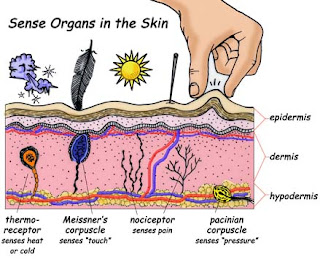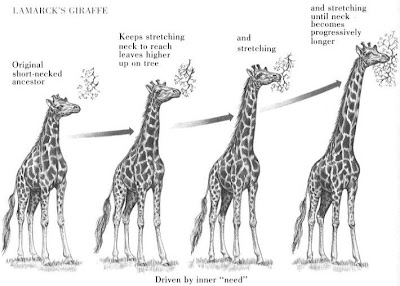Biology concepts – circadian rhythm, biological clock, periodicity, longevity
You get into bed but throw off the covers because you are hot. Hours later, you wake up shivering and go hunting for the discarded blanket. The temperature of the house has been the same all night, and your normal temperature is 98.6˚ F all the time, isn’t it? So why are your teeth chattering and toes blue?
 |
|
I think I make my own circadian rhythms, because I don’t feel
my fastest reactions come after lunch… and how many
people feel strongest right after work?
|
Your body has circadian rhythms (circa = around or near, and diem = day), certain patterns that it repeats every day. Towards night, your pineal gland releases melatonin, which causes sleepiness. While you sleep, your brain lowers your blood pressure, slows your heart rate and yes, reduces your temperature about 1%. Towards morning, your heart rate and blood pressure increase, and your temperature returns to normal as you get ready for the activity of the day.
Mammalian circadian rhythms work to conserve energy and reduce the amount of food we must consume- if these things didn’t occur, we would all need to get up in the middle of the night for a snack, just to be sure we could get up the next morning. Conserving energy is a big thing for biological organisms; it can mean the difference between surviving and perishing in times of nutrient scarcity.
Circadian rhythms were first described in plants. In 1729, a mimosa plant (the sensitive plants that fold their leaves up when you touch them. Here is a video: http://www.youtube.com/watch?v=g0LFBM3hOLs) being brought back to Europe in the hold of a ship was noted to still have a daily turning of the leaves, as if they were following the sun.
Rhythms in plants control fruiting, leaf budding and falling, and flowering. Plant clocks can be reset by light, temperature, or nutrient levels, so that plants can keep up with the changing of the seasons. It is interesting that some plants flower based on the number of hours of sunlight per day, while others take their cues from number of hours of darkness. This can be important for commerical nurseries.
We have seen that there are rhythms that run on daily schedules, monthly schedules, or seasonal schedules. Many mechanisms must work together to control the periodicity of the numerous functions and timetables. This implies a fairly complex level of control. Take your own daily clock for instance. Human biological clocks run on a 24.2 hour cycle, not 24. So if you are remain somewhere that provides no time cues, say…… a Las Vegas casino, within a couple of weeks you will end up sleeping all day and staying up all night. And you’ll be poor.
However, the longer period is an advantage. If all animals were on the same clock, then they would all want to eat at the same time, which would make competition greater. Our primitive selves were happy to have a clock that was slightly longer and could be reset for different seasons and locations on Earth, it improved their chances at survival.
You reset your clock each day by being exposed to sunlight. Neural tracts run from your retinas to the superchiasmatic nuclei (super = above, chiasm = crossing of two tracts to form an X, nucleus = group of neuron endings with similar function) of the brain. The light signal reboots your clock and keeps you on a 24 hr cycle.
A temperature cycle can be related other functions as well. Women tend to increase their body temperature just after ovulation, so this is an infradian rhythm (longer than one day) working with a circadian rhythm. Your body is most susceptible to fever at night when your temperature is lowest (in a study of patients with low white blood cell counts). This may be a mechanism for allowing the healing aspects of febrile response (fever, the increased temperature can slow down or kill pathogens) while reducing the chance that a body-damaging temperature will be reached.
It turns out that lower core body temperatures may also have other benefits. A recent study indicated that people who live longer have lower core body temperatures (were the colder able to get older, or do you get colder as you get older? – we can’t tell from this study). However, a study in mice showed that a lower average core body temperature in young mice did result in living longer.
 |
Is longer life really a blessing if you have to
starve yourself to get it?
|
How can you lower your normal body temperature? A 2010 study showed that long-term caloric restriction (1750 kCal/day) could lower core body temperature, and this was more important for longevity than was endurance exercise. Being colder means expending less energy, so less oxygen is needed, and therefore less oxidative damage is done (oxidative damage = aging). A recipe for living longer might be: don’t eat very much, sleep at least 10 hours/night, and stay calm. It is interesting how much control we can have on supposedly innate behaviors and natural outcomes.
Unfortunately, not all animals can make biological clock decisions for themselves. Some animal habitats don’t lend themselves to resetting clocks. Take arctic animals for example. For long periods of the year, there is either no day or no night. How can you hope to run a legitimate clock cycle under those conditions? Maybe there should be an exception to dependence on light cycles for clocks. Well, there is.
It turns out that arctic reindeer can turn their clocks off - sort of a biological snooze button. That way they can forage and nap, and forage and nap, not worrying about the time of day. No curfews for those teenagers! However, they must have some biologic sense of time, as they still mate and give birth in periods of relative food abundance.
 |
Without an internal clock to rely on, does Santa have to keep
reminding Rudolph when its about to time to deliver presents?
|
So arctic reindeer may have no rhythm, and they live where there isn’t much food, so they are probably extending their lives by caloric restriction as well – more time for dance lessons.
The arctic and antarctic patterns definitely mess with human clock function. As humans, we are still slaves to our clocks and to light entraining of the daily rhythm. Seasonal affective disorder (SAD, affect = mood, it is like the winter blahs gone nuclear) is common in people who live in the far north, and is thought to be responsible for high suicide rates noted in winter, especially in people from Finland. Light therapy is helpful, whether by resetting clocks or by stimulating the production of vitamin D. I wonder if the arctic deer are depressed as well?
Other animals maintain circadian rhythms without light stimuli. A 2011 study indicates that blind cave fish from Somalia, Phreatichthys andruzzii, seem to have a 47 hour infradian clock. It is interesting to me that our clock is just a hair over one day, while the P. andruzzii clock is just a hair under two days and other animals have clocks near multiples of 24 – I have no idea what that might suggest – I just find it mathematically intriguing.
 |
Cavefish have lost pigment as well as vision; neither
seem to matter much in a pitch black cave environment. |
Scientists do not know what triggers may reset the P. andruzzii's clock, but the fish’s natural rhythm may be influenced by the patterns of its prey or predators. A reset based on food intake is not out of the question, as one is suspected in humans, but the molecular mechanism has not been identified.
We have seen that plants and animals (as wells fungi and bacteria) have daily rhythms that control physiology, behavior and mental processing, and we have seen that body temperature rhythm is important for mammalian survival. However, next time we will see that the vast majority of living things do not micromanage their temperature like we do, and they get along just fine.
For more information, classroom activities, or laboratories:
Circadian rhythm –
Biological clocks –
Arctic reindeer –
Phreatichthys andruzzii –



















